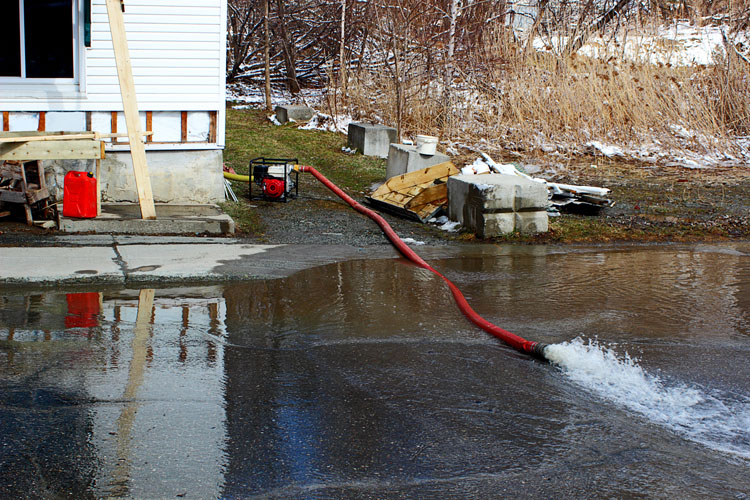Flood & Storm Damage Cleanup: Tips for Homeowners After Your House Floods
A flooded home can be devastating and disheartening. Beyond the initial shock and damage, homeowners face the daunting task of clean up and restoration. Working with a professional flood damage restoration service is highly recommended – but there are some steps you can take while you wait for the experts to arrive.
This article provides a guide to help you stay safe during this stressful time and give you some actionable advice for what to do after your home floods.
Stop the Water Supply
If your flood is due to a burst pipe, immediately shut off the main water supply to prevent additional flooding. Locating your home’s water-shutoff valve before an emergency is best – but sometimes this is a lesson learned too late!
If you are currently experiencing a plumbing-related emergency, water-shutoff valves are often located in a box buried near your water meter. Turn the valve or knob to the right (clockwise) to shut off the water flow. If you cannot locate your shut-off valve, contact a local plumber or your utility company. They will likely be able to tell you where it can be found.
Turn Off Electrical Systems
To avoid potential electrocution, shut down all electrical systems in the affected area if it is safe to do so. This should be done at your circuit breaker or fuse box by flipping your home’s master electrical breaker.
However, if there is standing water at your breaker box, do not go into the water! Call a professional electrician or your utility company for assistance.
Evacuate the Property
Floodwater can compromise the structural integrity of your home and make it unsafe. Once everyone is out of immediate danger, evacuate the property if necessary. Your personal safety is the top priority. If you are not certain that your home is structurally sound, leave the area and do not return until a professional is able to make an assessment.
Reach Out for Help
Renters should immediately notify their landlords about any flooding. Homeowners should call their insurance company to initiate an insurance claim. Your insurer will guide you on what to do next, and they may recommend a professional cleanup service.
You should ensure that you have somewhere safe to stay – ideally outside of the disaster area. Reach out to friends and family and make arrangements to stay elsewhere while the disaster is contained.
Document the Damage
Before starting the cleanup process, document the extent of the flood damage. Take pictures or videos of all affected areas, damaged belongings, and any visible structural damage. This documentation will be essential when dealing with your homeowners insurance company and filing a claim.
Remember to document everything – this is your chance to make a thorough record of your home’s inventory.
Start the Cleanup Process
Depending on the circumstances of your disaster, you may have the opportunity to start the cleaning process before your disaster remediation company arrives. The most important thing to keep in mind is that your personal safety comes first.
Natural disasters are incredibly stressful and dynamic situations, so please prioritize your safety and don’t attempt anything that could put you at risk.
Safety with Electrical Appliances
Treat all electrical appliances which have been exposed to water as though they are no longer safe to use. Attempting to dry out electrical devices yourself puts you and your family at risk of electric shock or fire in the event of a short circuit.
Safety with Gas Appliances
Floodwater can cause appliances to move, potentially damaging gas lines and causing gas leaks. If you smell gas or suspect a gas leak, shut off the gas supply if it’s safe to do so, evacuate the property, and call your gas company immediately.
Remove Carpets
When it comes to carpets, flooding typically results in significant damage. Carpets and carpet pads soak up water and become a breeding ground for bacteria and mold. In most cases, if a carpet has been saturated by floodwater, it will need to be removed and replaced. This is especially true if the water was contaminated, such as in cases of sewage backups or natural disasters.
Attempting to clean and dry flood damaged carpets will delay your home’s drying process and can lead to ongoing health risks and lingering odors.
Flooring
Hardwood and laminate floors may be salvageable if they are dried and cleaned quickly. However, it’s often necessary to remove and replace them to prevent mold growth underneath. This is a job best left to professionals.
Furniture
Move all affected furniture to a dry, well-ventilated area. Depending on the water exposure and material, some pieces may be salvageable.
Start the Drying Process
One of the most critical steps in flood cleanup is beginning the drying process as soon as possible. This involves removing standing water, promoting airflow, and using dehumidifiers to remove moisture from the air. For minor floods, a wet-dry vac can sometimes be sufficient to remove any standing water. For a more severely flooded home, a sump pump is oftentimes the only viable solution. Increase airflow by opening windows and doors if the weather allows it. Portable fans can be used to circulate air in the affected areas. Direct the airflow toward damp spots and try to keep the air moving constantly. Additionally, consider using dehumidifiers to accelerate the drying process. This is particularly important in enclosed spaces or heavily saturated rooms, as it helps to prevent the growth of mold and mildew.
Remember, the faster the drying process is started and completed, the less likely you will experience severe water damage and mold. Professional disaster remediation companies will use high-powered blowers and commercial grade dehumidifiers to accelerate the drying process.
Preventing Mold Damage
According to the Federal Emergency Management Agency (FEMA), mold growth can begin within 24-48 hours of a flood. To prevent this, it’s crucial to remove water-logged items as quickly as possible. Dehumidifiers and fans can help speed up the drying process. Always wear protective gear, such as gloves and a mask, when dealing with potential mold contamination.
For floods involving sewage or natural disasters where flood waters entered your home, it will be necessary to disinfect surfaces using a dilute bleach solution. FEMA recommends using a 10% bleach solution – mixing 1.25 cups of bleach with each gallon of water.
Your best bet for preventing mold from causing further damage is to work with a professional water removal company. They will have the tools and training necessary to ensure that your home is dried quickly and thoroughly.
Stay Safe and Start Drying Your Home Fast
Experiencing a home flood can be an overwhelming ordeal. It’s essential to prioritize your safety above all else. While these tips can guide you in the aftermath, professional help is crucial for comprehensive damage assessment and restoration.
As soon as it is safe to do so, reach out to your home insurance company and contact a water removal professional. After having done this, you can begin drying out your home – being mindful of your personal safety throughout the process.



